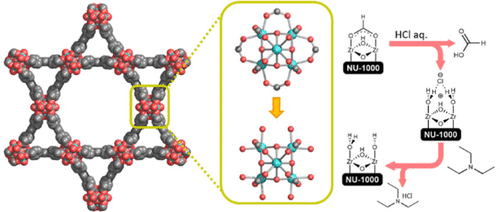当前位置:
X-MOL 学术
›
J. Am. Chem. Soc.
›
论文详情
Our official English website, www.x-mol.net, welcomes your
feedback! (Note: you will need to create a separate account there.)
Node-Accessible Zirconium MOFs
Journal of the American Chemical Society ( IF 14.4 ) Pub Date : 2020-12-02 , DOI: 10.1021/jacs.0c09782 Zhiyong Lu 1, 2 , Jian Liu 2 , Xuan Zhang 2 , Yijun Liao 2 , Rui Wang 2 , Kun Zhang 2, 3 , Jiafei Lyu 2, 4 , Omar K. Farha 2, 5 , Joseph T. Hupp 2
Journal of the American Chemical Society ( IF 14.4 ) Pub Date : 2020-12-02 , DOI: 10.1021/jacs.0c09782 Zhiyong Lu 1, 2 , Jian Liu 2 , Xuan Zhang 2 , Yijun Liao 2 , Rui Wang 2 , Kun Zhang 2, 3 , Jiafei Lyu 2, 4 , Omar K. Farha 2, 5 , Joseph T. Hupp 2
Affiliation

|
High-stability, zirconium-based metal-organic frameworks are attractive as heterogeneous catalysts and as model supports for uniform arrays of subsequently constructed heterogeneous catalysts-for example, MOF-node-grafted metal-oxy and metal-sulfur clusters. For hexa-Zr(IV)-MOFs characterized by nodes that are less than 12-connected, sites not used for linkers are ideally occupied by reactive and displaceable OH/H2O pairs. The desired pairs are ideal for grafting the aforementioned catalytic clusters, while aqua-ligand lability renders them effective for exposing highly Lewis-acidic Zr(IV) sites (catalytic sites) to candidate reactants. New single-crystal X-ray studies of an eight-connected Zr-MOF, NU-1000, reveal that conventional activation fully removes modulator ligands, but replaces them with three node-blocking formate ligands (from solvent decomposition) and only one OH/H2O pair, not four-a largely overlooked complication that now appears to be general for Zr-MOFs. Here we describe an alternative activation protocol that effectively removes modulators, avoids formate, and installs the full complement of terminal OH/H2O pairs. It does so via an unusual isolatable intermediate featuring eight aqua ligands and four non-ligated chlorides-again as supported by single-crystal X-ray data. We find that complete replacement of node-blocking modulators/formate with the originally envisioned OH/OH2 pairs has striking consequences; here we touch upon just three. First, elimination of unrecognized formate renders aqua ligands much more thermally labile, enabling open Zr(IV) sites to be obtained at lower temperature. Second, in the absence of formate, which otherwise links and locks pairs of node Zr(IV) ions, reversible removal of aqua ligands engenders reversible contraction of MOF meso- and micropores, as evidenced by X-ray diffraction. Third, formate replacement with OH/OH2 pairs renders NU-1000 ca.10× more active for catalytic hydrolytic degradation of a representative simulant of G-type chemical warfare agents.
中文翻译:

节点可访问的锆 MOF
高稳定性的锆基金属有机骨架作为非均相催化剂和作为随后构建的非均相催化剂(例如,MOF 节点接枝的金属氧簇和金属硫簇)的均匀阵列的模型载体很有吸引力。对于以少于 12 个连接节点为特征的六锆(IV)-MOF,不用于连接器的位点理想地被反应性和可置换的 OH/H2O 对占据。所需的配对是接枝上述催化簇的理想选择,而水配体的不稳定性使它们能够有效地将高路易斯酸性 Zr(IV) 位点(催化位点)暴露于候选反应物。八连接的 Zr-MOF,NU-1000 的新单晶 X 射线研究表明,常规激活完全去除了调节剂配体,但用三个节点阻断甲酸盐配体(来自溶剂分解)和只有一个 OH/H2O 对代替它们,而不是四个 - 现在似乎是 Zr-MOF 普遍存在的一种被严重忽视的并发症。在这里,我们描述了一种替代激活协议,它有效地去除了调节剂,避免了甲酸盐,并安装了完整的终端 OH/H2O 对。它是通过一种不寻常的可分离中间体实现的,该中间体具有八个水配体和四个未连接的氯化物 - 再次得到单晶 X 射线数据的支持。我们发现用最初设想的 OH/OH2 对完全替代节点阻塞调制器/甲酸盐会产生惊人的后果;这里我们只涉及三个。首先,消除未识别的甲酸盐使水配体更加热不稳定,从而能够在较低温度下获得开放的 Zr(IV) 位点。第二,在不存在甲酸盐的情况下,否则会连接和锁定节点 Zr(IV) 离子对,水配体的可逆去除导致 MOF 中孔和微孔的可逆收缩,如 X 射线衍射所证明。第三,用 OH/OH2 对取代甲酸盐使 NU-1000 对 G 型化学战剂的代表性模拟物的催化水解降解具有约 10 倍的活性。
更新日期:2020-12-02
中文翻译:

节点可访问的锆 MOF
高稳定性的锆基金属有机骨架作为非均相催化剂和作为随后构建的非均相催化剂(例如,MOF 节点接枝的金属氧簇和金属硫簇)的均匀阵列的模型载体很有吸引力。对于以少于 12 个连接节点为特征的六锆(IV)-MOF,不用于连接器的位点理想地被反应性和可置换的 OH/H2O 对占据。所需的配对是接枝上述催化簇的理想选择,而水配体的不稳定性使它们能够有效地将高路易斯酸性 Zr(IV) 位点(催化位点)暴露于候选反应物。八连接的 Zr-MOF,NU-1000 的新单晶 X 射线研究表明,常规激活完全去除了调节剂配体,但用三个节点阻断甲酸盐配体(来自溶剂分解)和只有一个 OH/H2O 对代替它们,而不是四个 - 现在似乎是 Zr-MOF 普遍存在的一种被严重忽视的并发症。在这里,我们描述了一种替代激活协议,它有效地去除了调节剂,避免了甲酸盐,并安装了完整的终端 OH/H2O 对。它是通过一种不寻常的可分离中间体实现的,该中间体具有八个水配体和四个未连接的氯化物 - 再次得到单晶 X 射线数据的支持。我们发现用最初设想的 OH/OH2 对完全替代节点阻塞调制器/甲酸盐会产生惊人的后果;这里我们只涉及三个。首先,消除未识别的甲酸盐使水配体更加热不稳定,从而能够在较低温度下获得开放的 Zr(IV) 位点。第二,在不存在甲酸盐的情况下,否则会连接和锁定节点 Zr(IV) 离子对,水配体的可逆去除导致 MOF 中孔和微孔的可逆收缩,如 X 射线衍射所证明。第三,用 OH/OH2 对取代甲酸盐使 NU-1000 对 G 型化学战剂的代表性模拟物的催化水解降解具有约 10 倍的活性。











































 京公网安备 11010802027423号
京公网安备 11010802027423号